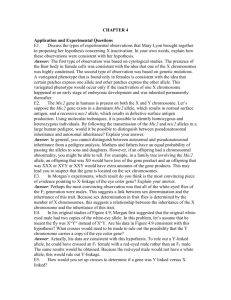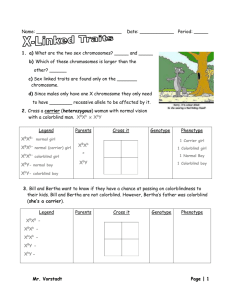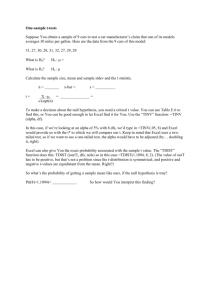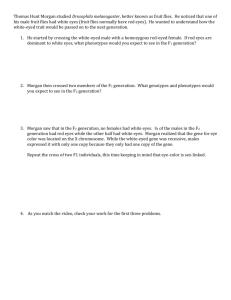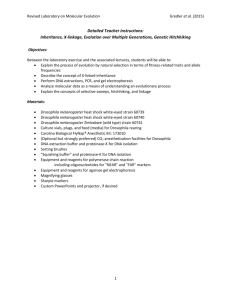Word
advertisement
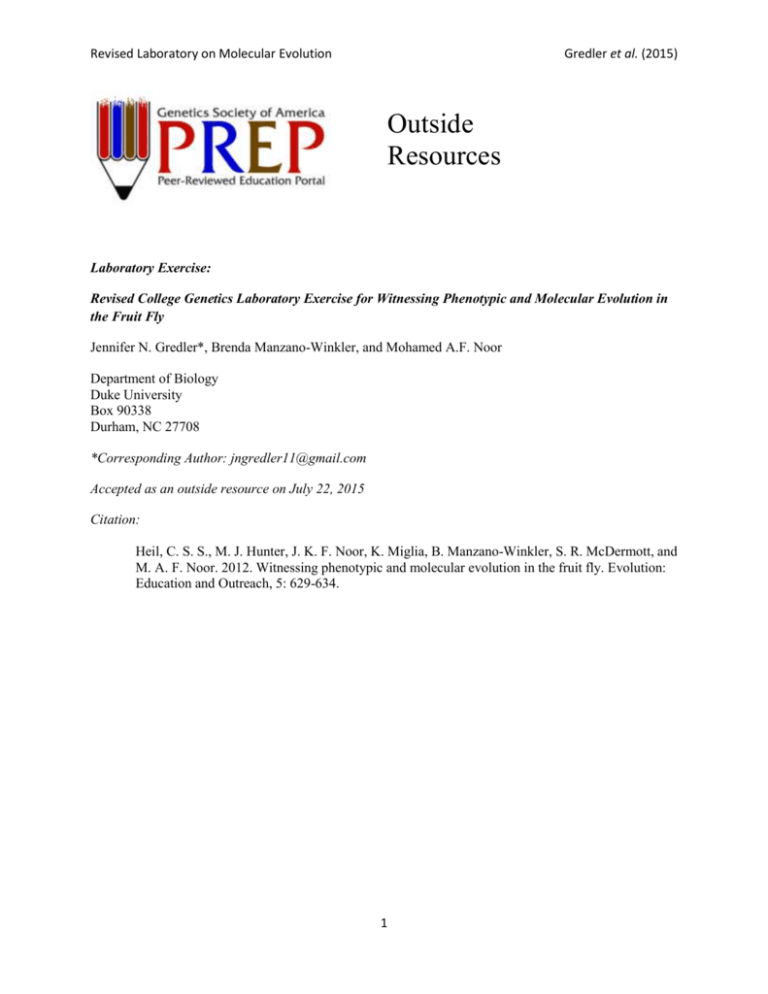
Revised Laboratory on Molecular Evolution
Gredler et al. (2015)
Outside
Resources
Laboratory Exercise:
Revised College Genetics Laboratory Exercise for Witnessing Phenotypic and Molecular Evolution in
the Fruit Fly
Jennifer N. Gredler*, Brenda Manzano-Winkler, and Mohamed A.F. Noor
Department of Biology
Duke University
Box 90338
Durham, NC 27708
*Corresponding Author: jngredler11@gmail.com
Accepted as an outside resource on July 22, 2015
Citation:
Heil, C. S. S., M. J. Hunter, J. K. F. Noor, K. Miglia, B. Manzano-Winkler, S. R. McDermott, and
M. A. F. Noor. 2012. Witnessing phenotypic and molecular evolution in the fruit fly. Evolution:
Education and Outreach, 5: 629-634.
1
Revised Laboratory on Molecular Evolution
Gredler et al. (2015)
Overview:
Our team recently published a laboratory exercise in which college students observe both phenotypic
and molecular evolution through natural selection in a population of Drosophila simulans over the
course of a few months. This exercise takes advantage of eye color variation and molecular variation in a
live model organism to demonstrate the transmission genetic concepts of X-linked inheritance and
linkage as well as the evolutionary genetic concepts of selective sweeps and hitchhiking. To make this
activity more accessible to a broader audience of novice fly handlers, we have constructed strains of
Drosophila melanogaster that eliminate the difficult, time-consuming steps of collecting virgin females
to be used in crosses, and designed new markers to be used with this species. We describe the changes
to the activity, how the strains were constructed, and results from a test-run of the revised activity. An
overview of the activity, supplementary detailed teacher instructions, and supplementary student
handouts are presented here.
Core Concepts Addressed:
Nature of genetic material: What are the mechanisms by which an organism's genome is passed on to
the next generation?
Transmission/ patterns of inheritance: How does the phenomenon of linkage affect the assortment of
alleles during meiosis? How can one deduce information about genes, alleles, and gene functions from
analysis of genetic crosses and patterns of inheritance?
Evolution: What are the processes that can affect the frequency of genotypes and phenotypes in a
population over time?
Core Competencies Addressed:
Observational strategies/ Hypothesis testing/ Experimental design
Evaluation of experimental evidence
Audience:
Intermediate undergraduate, biology/genetics majors
Activity Type:
Open-ended laboratory
Activity Length:
4-6 activity days spread across 2-3 months
2
Revised Laboratory on Molecular Evolution
Gredler et al. (2015)
Original Activity and Justification for Revision:
Our research group recently published a hands-on laboratory exercise in which students observe
evolution by natural selection in a live population of Drosophila simulans (Heil et al. 2012). In this
exercise, students place a single red-eyed male fly into a population of white-eyed flies and observe the
spread of the advantageous red-eyed phenotype over three to four generations, with individual
generations taking approximately eleven days. Students observe that male flies with white eyes are less
successful at mating than their red-eyed (wild-type) counterpart. Thus, the higher fitness associated
with flies having red eyes is favored, and this trait increases in frequency in subsequent generations
through the process of natural selection.
Not only are students able to witness phenotypic evolution in living organisms over a few months with
this activity, students also study molecular evolution, partaking in a meaningful and valuable hands-on
experience with molecular techniques that include DNA extraction, PCR, and gel electrophoresis. Here,
the students examine two molecular markers, one near the eye color locus (white) and one on the
opposite end of the same chromosome, and see that, while allelic variation is maintained at the locus far
away from the eye color locus, a single allele at the marker near the eye color gene spreads with the
red-eyed flies. Overall, this lab demonstrates the genetic principles of X-linked inheritance, linkage,
selective sweeps, and hitchhiking.
Since the efficacy of this lab depends on the increase of the red eye allele over time, the white-eyed
female flies in the cross set up by the students on Day 1 must be virgins. If non-virgin white-eyed
females are used in this activity, the activity may not progress as planned (e.g., perhaps more whiteeyed offspring will be observed than expected). Likewise, the proper demonstration of selective sweeps
and hitchhiking requires that the initial populations of white-eyed flies the students cross on Day 1 have
ample allelic variability at the two molecular markers. If non-virgin white-eyed females are used in the
first cross set up by teachers during the in-advance preparation, the experiment could fail, create and
propagate misconceptions, and/ or cause an undetectable (or no) spread of the red eye allele over the
course of the experiment. Given that most faculty and staff in charge of coordinating and running
undergraduate teaching labs have limited experience handling flies, the likelihood of non-virgin females
being used in the lab is non-trivial.
As a way of side-stepping this problem and the time-consuming, error-prone nature of virgin collecting,
we have constructed white-eyed heat shock male-lethal strains of Drosophila melanogaster that will
ensure the collection of virgin females. We further develop new molecular markers by leveraging
available transposable element (TE) insertion strains, and crossing the heat-shock-sensitive Ychromosome into those strains. We amend the protocol published previously (Heil et al. 2012) for use
with these new strains. This new approach virtually eliminates the possibility for use of non-virgin
females, and simplifies the exercise for faculty and staff setting up the activity.
Heat shock treatment begins when larvae start encasing themselves in pupal cases and ends when adult
flies begin to emerge (which will all be virgin females!). The treatment consists of placing vials of pupae
in an incubator (or oven) set at 37°C (98.6°F) for one hour each day or every two days, leaving them at
room temperature otherwise. Once adults begin to emerge, females can be collected until there are no
more adults left in the vial and heat shock treatment continued until all females needed for the activity
are collected. This treatment will not harm the larvae, and must be done in the pupal stage of
development to work.
3
Revised Laboratory on Molecular Evolution
Gredler et al. (2015)
Heat shocking vials of these flies produces all females, while leaving the flies at room temperature
produces both males and females. Educators will still need to separate the males and females by sex in
vials left at room temperature to collect and isolate males.
In summary, the activity presented here utilizes the protocol and concepts addressed in Heil et
al. (2012) with the added improvements of using heat shock D. melanogaster strains as
opposed to D. simulans strains. For students, the overall activity will appear identical to the one
first described in Heil et al. (2012), but the present version dramatically reduces setup time and
effort and mitigates the risk of non-virginity of the flies in the crosses. We have included revised
versions of the Teacher Instructions and Student Handouts to accommodate changes made to
the lab exercise associated with the new heat shock strains.
Links to ORIGINAL D. simulans Activity and Supplemental Materials:
Heil et al. 2012:
http://dx.doi.org/10.1007/s12052-012-0447-5
Teacher/Student Instructions and Powerpoints:
https://sites.google.com/site/noorlabduke/fly-evolution-advanced
Protocol Used for Creation of the Heat Shock D. melanogaster Lines:
We created a white-eyed, heat shock Y-susceptible strain by crossing a D. mel w(1) strain obtained from
Carolina Biological Supply to a heat shock susceptible strain (stock #25679) obtained from the
Bloomington Drosophila Stock Center at Indiana University. F1 males from this new white-eyed hybrid
strain were backcrossed to D. mel w(1) virgin females for 10 generations, then tested for male heat
shock susceptibility and maintained in lab. Males from the heat shock hybrid strain were then crossed to
D. mel (w1118) females containing an Mi{ET1} transposable element both near the eye color gene on
the X chromosome (stock #25634) AND D. mel (w1118) females containing a Mi{ET1} transposable
element on the opposite end of the X chromosome (stock #25312). Both of these strains were obtained
from Bloomington Drosophila Stock Center at Indiana University. F1 males were then backcrossed to
pure females (25634 and 25312) to ensure that the females remained homozygous for the inserted
genetic element. The new transposable element heat-shock susceptible strains were then tested to
confirm the successful transmission of Y-heat shock susceptibility and female non-susceptibility and
maintained in lab. The Mi{ET1} white-eyed strains were chosen to aid in the development of markers
close to and far from the eye color locus on the X-chromosome for the molecular component of the lab.
We refer to these new strains as heat shock white-eyed strain 60739 (has TE insert near the eye color
gene) and heat shock white-eyed strain 60740 (has TE insert far from eye color gene) in the protocol.
NOTE: The D. melanogaster strains used in this laboratory are available to be ordered at
Bloomington Drosophila Species Stock Center under stock numbers:
60739: heat-shock-sensitive-Y, white-eyed flies with TE insert near eye-color gene
60740: heat-shock-sensitive-Y, white-eyed flies with TE insert far from eye-color gene
60741: wild-type (red-eyed) flies from Zimbabwe (strain S29), neither TE insertion
4
Revised Laboratory on Molecular Evolution
Gredler et al. (2015)
Documentation of Spread of Red Eye Phenotype with Revised Protocol:
We executed a test-run of our revised procedure to ensure that the red eye phenotype still increases in
abundance. We started with 20% of the males having red eyes (4 white-eyed males, 1 red-eyed male). If
the red-eyed fly had equal fitness to the white-eyed flies, then 20% of the female progeny in generation
1 should have red eyes. Among generation 1 vials we examined, every vial (10/10) had a higher fraction
of red-eyed females than 20%, averaging closer to 60% (range 29%-91%). As expected for an X-linked
trait, none of the generation 1 males had red eyes. The fraction of flies (male + female) with red eyes in
generations 3 and 4 averaged 41% (range 8%-62%) and 44% (range 8%-85%) respectively.
Learning Objectives:
By the end of the laboratory exercise, students will be able to:
Explain the process of evolution by natural selection in terms of fitness-related traits and allele
frequencies
Describe the concept of X-linked inheritance
Perform DNA extractions, PCR, and gel electrophoresis
Analyze molecular data as a means of understanding an evolutionary process
Explain the concepts of selective sweeps, hitchhiking, and linkage
Overview of Student Activities:
Day One: Set Up Fly Crosses and Observe Matings Time: 30+ min.
In an introductory lecture, students are given a brief overview of the concepts of inheritance and
evolution by natural selection. Students are then given two vials of flies: one with four white-eyed
females, and one with four white-eyed males and one red-eyed male. Once the students have examined
their flies and feel comfortable telling apart the differences between males and females and between
eye colors in the vial of males, students are asked to predict what will happen to the percentage of redeyed flies in future generations if the having red eyes confers a fitness advantage or confers a lower
fitness (is disadvantageous). Students then combine males and females into a single vial and observe the
behavior of the flies. The students should see courtship behavior and mating within 5-10 minutes,
though sometimes this may take longer. The first mating that students almost always observe is
between the red-eyed male and a white-eyed female. Thus, students infer that the better vision and
health associated with having red eyes helps the red-eyed male find and pursue his mates more easily,
giving him an advantage at passing on his alleles to the next generation relative to the white-eyed
males.
Day Two: Examine Generation 1 Offspring and Observe X-linked Inheritance Time: 30+ min.
Approximately two weeks later, students are given back the offspring (referred to as generation 1) from
the crosses they set up and observed on Day One. Students put the flies to sleep using either CO2 or
FlyNap, and sort them by sex and eye color. They will notice that there are no red-eyed males. If having
red eyes is advantageous, especially for males in terms of finding mates, why do none of the males have
red eyes? The teacher then explains to the students that eye color in Drosophila is X-linked, and that the
red eye allele is dominant over the white-eye allele. Thus, when a red-eyed male mates with a white-
5
Revised Laboratory on Molecular Evolution
Gredler et al. (2015)
eyed female, all of their daughters will have red eyes, but all of their sons will have white eyes since the
only X chromosome they inherit will come from their white-eyed mother.
Day Three: See Evolution by Natural Selection and Begin Molecular Component
Part 1: Evolution by Natural Selection Time: 20-30 min.
Approximately five weeks after Day Two, students are given back the fourth (or third) generation
offspring from their Day One crosses. Once again, the students sort the flies by sex and eye color, and
calculate the frequency of red-eyed flies in their populations. Students should see that close to half of
the flies have red eyes. Thus, if the frequency of red-eyed flies in their population is greater than the
starting frequency of red-eyed flies in the original population on Day One (1/9 or 11%), then the
students have witnessed evolution by natural selection. Students are able to confirm that evolution by
natural selection occurred in the following ways:
1. The definition of evolution is change in a population over time. The change in frequency of the whiteeyed and red-eyed individuals over multiple generations demonstrates this.
2. The population was variable, containing both red and white-eyed individuals. This allows the
opportunity for natural selection to favor one trait over another.
3. The variation was heritable since eye color is inherited in an X-linked manner.
4. The spread of red eyes occurred in a predictable manner, with the proportion of red-eyed flies
increasing in frequency in subsequent generations.
Part 2: DNA Extraction Time: 45-60 min.
Here, students are introduced to the concept of examining molecular evolution by looking at variable
“markers” within an organism’s genome. The students randomly select seven male flies (preferably 4 of
one eye color and 3 of the other, with 1 negative control) and place them each in a separate well of 0.2
ml microcentrifuge strip tubes. They then add a mixture of buffer and proteinase K to each well, and
crush the body of the flies to release DNA into the solution using the end of a sterile pipette tip. Once all
seven of the flies have been thoroughly squished, the strip tubes are placed in a thermal cycler for 32
minutes to prepare the DNA samples for PCR.
Day Four: Polymerase Chain Reaction (PCR) Time: 30 min. prep, 75 min. thermal cycler
Students set up two PCRs using the seven DNA samples they prepared to amplify two markers along the
X chromosome: one near the eye color locus (referred to as the "NEAR" marker) and one on the
opposite end of the chromosome (referred to as the "FAR" marker). Thus, students end up with a total
of 16 amplified DNA samples (including two negative control samples) that they visualize on a gel in the
following class period.
Depending on the amount of time in each lab period, this step can be combined with Day Three
activities. If needed, students can set up their PCRs and put them in thermal cyclers, while the lab
instructor or prep staff comes back approximately an hour and fifteen minutes later to put the finished
PCR products in the refrigerator until needed in Day Five.
6
Revised Laboratory on Molecular Evolution
Gredler et al. (2015)
Day Five: Gel Electrophoresis Time: 75 min.
Students first practice their gel loading skills by pipetting loading dye into petri dishes containing
agarose. Once students feel comfortable loading a gel, their PCR products from Day Four are returned to
them. They then load their 16 samples into an agarose gel and let it run. The gel is then imaged and used
by students for analysis.
Note: Gel electrophoresis and data analysis can be combined in the same day depending on the amount
of time allotted for each lab period.
Day Six: Data Analysis: Observation of Selective Sweep/Genetic Hitchhiking Time: 30 min.
Students examine their gel images and record the alleles that both the red and white-eyed flies have at
both the NEAR and FAR markers. Students should see that all of the red-eyed males have the larger size
allele at the NEAR marker, while the white-eyed flies have both the larger size and smaller size alleles. At
the FAR marker, both the red and white-eyed males will have two alleles. The loss of variation in alleles
at the NEAR marker in red-eyed males demonstrates a selective sweep and the hitchhiking of a neutral
variant along with a selected variant at the eye color locus. In this case, the larger size allele is
genetically linked to the red eye allele at the eye color locus, and thus increases to high frequencies with
the spread of the red eye allele. Alleles at the FAR locus are not linked to the eye color locus, and are
therefore separated by recombination and minimally affected by the selective sweep occurring at the
eye color locus.
Concept Summary:
Revised Figure from Heil et al. (2012)
The initial population consists of white-eyed flies that carry two alleles at the NEAR marker (pink or
green), two alleles at the FAR marker (purple or yellow), and the white allele at the eye color gene. A
7
Revised Laboratory on Molecular Evolution
Gredler et al. (2015)
red-eyed fly is introduced that carries the pink allele at the NEAR marker, purple at the FAR marker, and
red at the eye color gene. The red eye allele is advantageous and sweeps to higher frequencies in the
population. The pink allele at the NEAR marker is located close to the advantageous eye color and
hitchhikes with the red eye color. The FAR marker is located on the opposite end of the chromosome.
Recombination breaks down linkage between eye color and the FAR marker, so both purple and yellow
alleles persist in the population.
Sample Timeline for Crosses Based on Our Trial Run:
Teacher Cross 1 (near insert females with far insert males): Set up December 23
Teacher Cross 2 (F1 brother-sister cross): Set up January 3
F2 offspring start emerging: January 15
Student Cross Day 1 (4 white-eyed females, 4 white-eyed males, 1 red-eyed male): set up January 20
Generation 1 emerges: January 30
Generation 2 emerges: February 10
Generation 3 emerges: February 22
Generation 4 emerges: March 4
8
Revised Laboratory on Molecular Evolution
Gredler et al. (2015)
References:
Heil, C. S. S., M. J. Hunter, J. K. F. Noor, K. Miglia, B. Manzano-Winkler, S. R. McDermott, and M. A. F.
Noor. 2012. Witnessing phenotypic and molecular evolution in the fruit fly. Evolution: Education and
Outreach, 5: 629-634.
9

